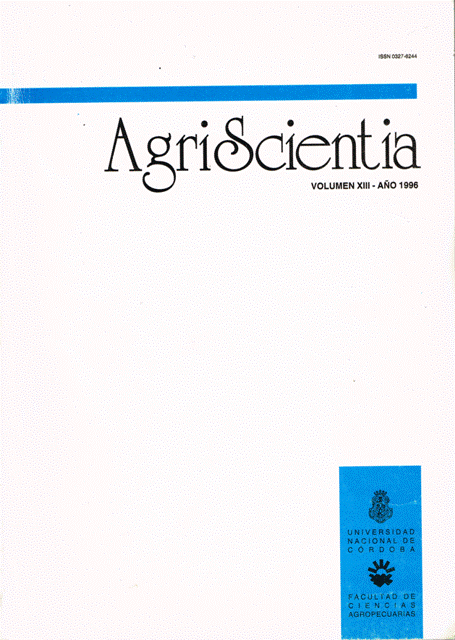Corn-soybean intercropping. A contribution to sustainability in the semi-arid region of Argentina.
Main Article Content
Abstract
The objective of this study was to evaluate the grain yield per unit of area of the corn-soybean intercropping in relation to their monoculture as a sustainable management alternative in the semiarid zone of Córdoba, Argentina. The Land Equivalent Ratio (LER), whose indifference value is 1, was 1.09 and 1.11 in the first and second essay, respectively. The intercropped corn was benefited in both experiences, while the intercropped soybean had a more indifferent behavior. The experimental evidence suggests that intercropping corn-soybean is a potential technology for the design of more sustainable systems, as it allows for an increase in grain yield per unit of area without additional agronomical inputs.
Article Details

This work is licensed under a Creative Commons Attribution-ShareAlike 4.0 International License.
How to Cite
References
Ahmed, S., & Rao, M. R. (1982). Performance of maize-soybean intercrop combinations in the tropics: Results of multi-location study. Field Crops Research, 5, 147–161.
Alexander, M., & Genter, C. (1962). Production of corn and soybean in alternate pairs of rows. Agronomy Journal, 54, 233–234.
Berkowitz, A. R. (1988). Competition for resources in weed-crop mixtures. In M. Altien & M. Liebman (Eds.), Weed management in agroecosystems: Ecological approaches (pp. 89–119). CRC Press.
Beste, C. (1976). Co-cropping setcorn and soybeans. Horticultural Science, 11, 236–238.
Bolsa de Cereales de Buenos Aires. (1993). Número estadístico. Buenos Aires, Argentina.
Crookston, K., & Hill, D. (1979). Grain yields and land equivalent ratios from intercropping corn and soybeans in Minnesota. Agronomy Journal, 71, 41–44.
Chu, J., & Shibles, R. (1984). Influence of spatial arrangements of maize on performance of an associated soybean intercrop. Field Crops Research, 8, 187–198.
Dalai, R. C. (1977). Effect of intercropping of maize with soybean on grain yield. Tropical Agriculture, 54, 189–191.
Galacher, M. (1991). Agricultura sostenible en la empresa rural: Posibilidades económicas. Juicio a nuestra agricultura hacia un desarrollo sostenible. Hemisferio Sur.
Gardner, F. P., Pearce, R. B., & Mitchell, R. L. (1985). Physiology of crop plants (pp. 12–17). Iowa State University Press.
Instituto Nacional de Tecnología Agropecuaria (INTA) y Secretaría de Agricultura, Ganadería y Recursos Renovables (SEAGyRR). (1987). Plan Mapa de Suelos Córdoba. Argentina.
Mohta, N. K., & De, R. (1980). Intercropping maize and sorghum with soybean. Journal of Agricultural Science, 95, 117–122.
Paul, C. L. (1990). Agronomía del sorgo. Instituto Internacional para la Investigación en Cultivos para los Trópicos Semiáridos.
Power, A., & Kareiva, P. (1990). Herbivorous insects in agroecosystems. In R. Carroll, J. Vandermeer, & P. Rosset (Eds.), Agroecology (pp. 301–327). McGraw-Hill.
Puig, R., Garcia, R., & Rivoltella, A. (1980). Cultivo de maíz y soja en franjas alternadas. Información N° 95, EEA Pergamino, Argentina.
Ravelo, A., & Seiler, S. (1974). Influencia del efecto protector de cortinas de maíz en el rendimiento del cultivo de soja. IDIA Suplemento, 30, 64–70.
Searle, P. G., Comudon, Y., Shedden, D. C., & Nance, R. A. (1981). Effect of maize-legume intercropping systems and fertilizer nitrogen on crop yields and residual nitrogen. Field Crops Research, 4, 133–145.
Trenbath, R. B. (1974). Biomass production of mixtures. Advances in Agronomy, 26, 177–210.
Vandermeer, J. (1990). Intercropping. In R. Carroll, J. Vandermeer, & P. Rosset (Eds.), Agroecology (pp. 481–516). McGraw-Hill.
Wahua, T. A. T., & Miller, D. A. (1978). Relative yield totals and yield components of intercropped sorghum and soybeans. Agronomy Journal, 70, 287–291.
Willey, R. W. (1979). Intercropping: Its importance and research needs. Field Crops Abstracts, 32, 1–73–84.
Yunusa, I. A. M. (1989). Effects of planting density and plant arrangement pattern on growth and yields of maize and soybean grown in mixtures. Journal of Agricultural Science, 112, 1–8.





